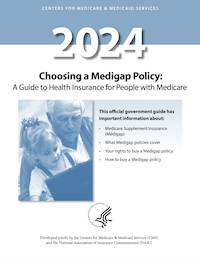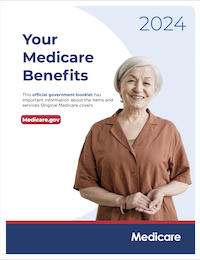Medicare Plans
What Are My Options for Medicare Prescription Drug Coverage (Part D)?

Medicare offers prescription drug coverage (Part D) to everyone with Medicare. To get Medicare drug coverage, you must join a plan run by an insurance company or other private company approved by Medicare. Each plan can vary in cost and drugs covered. There are two ways to get Medicare prescription drug coverage:
- Medicare Prescription Drug Plans. These plans (sometimes called "PDPs") add drug coverage to Original Medicare, some Medicare Cost Plans, some Medicare Private Fee-for-Service (PFFS) Plans, and Medicare Medical Savings Account (MSA) Plans.
- Medicare Advantage Plans (like an HMO or PPO) or other Medicare health plans that offer Medicare prescription drug coverage. You get all of your Part A and Part B coverage, and prescription drug coverage (Part D), through these plans. Medicare Advantage Plans with prescription drug coverage are sometimes called "MA-PDs."
Why Join a Medicare Drug Plan?
Even if you don't take a lot of prescription drugs now, you should still consider joining a Medicare drug plan. If you decide not to join a Medicare drug plan when you are first eligible, and you don't have other creditable prescription drug coverage (also called creditable coverage), you will likely pay a late enrollment penalty (higher premiums) if you join later.
Note: Discount cards, doctor samples, free clinics, drug discount Web sites, and manufacturer's pharmacy assistance programs aren't considered prescription drug coverage and aren't creditable coverage. If you have limited income and resources, you may qualify for Extra Help from Medicare to pay for prescription drug coverage. You may also be able to get help from your state.
Who Can Get Medicare Drug Coverage?
To join a Medicare Prescription Drug Plan, you must have Medicare Part A and/or Part B. If you would like to get prescription drug coverage through a Medicare Advantage Plan, you must have Part A and Part B. You must also live in the service area of the Medicare drug plan you want to join.
If you have employer or union coverage, call your benefits administrator before you make any changes, or before you sign up for any other coverage. If you drop your employer or union coverage, you may not be able to get it back. You also may not be able to drop your employer or union drug coverage without also dropping your employer or union health (doctor and hospital) coverage. If you drop coverage for yourself, you may also have to drop coverage for your spouse and dependents.
When Can You Join, Switch, or Dis-enroll from a Medicare Drug Plan?
Enrolling into a Medicare Drug Plan or switching plans may be done at these times:
- You can join when you are first eligible for Medicare (the 7 month period that begins 3 months before the month you turn age 65, includes the month you turn age 65, and ends 3 months after the month you turn age 65).
- If you get Medicare due to a disability, you can join during the 3 months before to 3 months after your 25th month of disability. You will have another chance to join 3 months before the month you turn age 65 to 3 months after the month you turn age 65.
- Plan changes may be requested during the Annual Election Period, which runs from October 15 - December 7 each year. Your new coverage begins on January 1 of the following year, as long as your enrollment request is received by the plan on time.
- You may enroll in a new Medicare Drug Plan during the new Medicare Advantage Open Enrollment Period (runs from January 1 – March 31 each year), if you are dis-enrolling from a Medicare Advantage Plan during that time. Your new drug coverage begins on the first day of the month following the date the plan receives your enrollment form.
-
If you are eligible for Medicare and Medicaid, or if you can qualify for Extra Help,
you can make one change one time during each of these periods:
- January - March
- April - June
- July - September
If you make a change, it will take effect on the first day of the following month. You'll have to wait for the next period to make another change. You can't use this Special Enrollment Period from October–December. However, all people with Medicare can make changes to their coverage from October 15–December 7, and the changes will take effect on January 1.
- If you are enrolled in a State Pharmaceutical Assistance Program (SPAP) or lose SPAP eligibility, you can join a Medicare Part D plan or a Medicare Advantage Plan with prescription drug coverage once during the calendar year.
In most cases, you must stay enrolled for that calendar year starting the date your coverage begins. However, in certain situations, you may be able to join, switch, or drop Medicare drug plans during a special enrollment period (like if you move out of the service area, lose other creditable prescription drug coverage, or live in an institution).
What You Pay
Exact coverage and costs are different for each Medicare drug plan, but all plans must provide at least a standard level of coverage set by Medicare. Your actual drug plan costs will vary depending on the prescriptions you use, the plan you choose, whether you go to a pharmacy in your plan's network (and with some plans, if you utilize the plan's preferred mail-order pharmacy), whether your drugs are on your plan's formulary, and whether you qualify for Extra Help paying your Part D costs.
The following points show the components of a Medicare Part D Drug plan:
- Monthly premium - Most drug plans charge a monthly fee that varies by plan. You pay this in addition to the Part B premium. If you belong to a Medicare Advantage Plan (like an HMO or PPO) or a Medicare Cost Plan that includes Medicare prescription drug coverage, the monthly premium may include an amount for prescription drug coverage.
- Yearly deductible - Amount you pay for your prescriptions before your plan begins to pay. Some drug plans don't have a deductible. In 2024, the deductible cannot exceed $545 (increases to $590 in 2025).
- Copayments or coinsurance - Amounts you pay at the pharmacy for your covered prescriptions after the deductible. You pay your share, and your drug plan pays its share for covered drugs.
- Coverage gap - This is also known as the "Donut Hole". Under the original Part D program, most Medicare drug plans had a complete coverage gap that has been phased out between 2010 and 2020. Once you reach the 2024 Part D coverage gap of $5,030, your cost for your medications will be limited to 25%, same as before the coverage gap. In 2025, the coverage gap is being eliminated.
- Catastrophic coverage - Once you reach your plan's out-of-pocket limit during the coverage gap, you automatically get "catastrophic coverage". Catastrophic coverage assures that once you have spent up to your plan's out-of-pocket limit for covered drugs, you only pay a small coinsurance amount or copayment for the drug for the rest of the year. In 2024, once you've spent $8,000 out-of-pocket for the year (including drug discounts paid by the drug manufacturers when you are in the coverage gap), you get catastrophic coverage. In 2025, the out-of-pocket cap decreases to $2,000 then all coinsurance and copayments cease.
You might spend even less if you are one of the roughly 75% of Part D members with an "enhanced" Part D plan, which may provide extra credit toward the out-of-pocket cap. When enhanced plans have benefits that reduce out-of-pocket spending, the value of those benefits can count toward your $2,000 cap. As a result, in 2025 many Medicare beneficiaries will hit the cap before actually spending $2,000 in out-of-pocket costs.
Low Income Subsidy (LIS) Program
The Medicare prescription drug benefit includes Extra Help for people with limited incomes and resources who need help with their Medicare prescription costs.
People with limited incomes and resources may qualify for Extra Help to pay for their prescription drug costs. If you qualify, Medicare could pay for up to seventy-five (75) percent or more of your drug costs including monthly prescription drug premiums, annual deductibles, and co-insurance. Additionally, those who qualify will not be subject to the coverage gap or a late enrollment penalty. Many people are eligible for these savings and don't even know it. For more information about this Extra Help, contact your local Social Security office or call 1-800-MEDICARE (1-800-633-4227) 24 hours a day, 7 days a week. TTY users should call 1-877-486-2048.
Changes in 2024 to the Part D Program
In 2024, costs in the Catastrophic stage change so that the 5% coinsurance requirement is eliminated (Part D plans will pay 20% of total drug costs in this phase instead of 15%). Once Part D enrollees (without low-income subsidies, called LIS), have drug spending high enough to qualify for Catastrophic Coverage, they are no longer required to pay 5% of their drug costs, which in effect caps their expenses.
In 2024, the Catastrophic stage threshold will be set at $8,000. This amount includes what Part D enrollees spend out of pocket plus the value of manufacturer discounts in the Coverage Gap. Under this construct, Part D enrollees who take only brand-name drugs in 2024 will spend approximately $3,300 out of pocket and then have no further cost for covered medicines. Consequently (see example below), the enrollee reduces out-of-pocket medicine costs from over $16,000 in 2023 to about $3,300 in 2024.
To illustrate actual 2023 out-of-pocket drug costs on a standalone PDP, let's review a hypothetical example for a Medicare beneficiary living in Tampa, Florida and taking one costly medicine -- Pomalyst 3mg capsule. Then, we will see how much the enrollee's out-of-pocket costs will be reduced in 2024 and 2025.
The monthly premium is ignored, but it should be noted that the Plan Sponsor selected in this example provides the lowest standalone Part D 2023 calendar year costs including premiums and drug copays.
According to the Medicare plan finder, this consumer travels through both Initial Coverage and the Coverage Gap in January. The $7,400 TrOOP is reached, with the enrollee's out-of-pocket drug cost equal to $3,080. For the rest of the year, the enrollee is in Catastrophic Coverage paying $1,188 monthly (5% of $23,762 pharmacy retail cost). Over the whole calendar year, the enrollee's out-of-pocket drug costs exceed $16,000 (based on the specific 2023 PDP and retail pharmacy).
In 2024, with the 5% coinsurance eliminated in the Catastrophic stage, the enrollee's out of pocket drug costs are only about $3,300 in 2024. This is due to the enrollee not having to pay 5% of the pharmacy retail cost ($1,188 monthly) in the Catastrophic stage.
Changes in 2025 to the Part D Program
Out-of-pocket drug spending will be capped at $2,000.
Beginning in 2025, Part D enrollees' out-of-pocket drug costs will be capped at $2,000. This amount will be indexed to rise each year after 2025 at the rate of growth in per capita Part D costs. (This cap does not apply to out-of-pocket spending on prescription drugs covered under Medicare Part B.)
For Part D enrollees who take only brand name drugs, annual out-of-pocket costs at the Catastrophic threshold will fall from around $3,300 in 2024 to $2,000 in 2025. In other words, Part D enrollees who take only brand name drugs with costs high enough to reach the Catastrophic stage should expect to realize savings of about $1,300 in 2025 as compared to 2024 spending.
The Coverage Gap will be completely eliminated.
The Coverage Gap stage, where Part D enrollees had faced 100% of total drug costs under the original Part D design and currently face 25% of costs, will be eliminated in 2025. This means that Part D enrollees will no longer face an increase in cost sharing at the end of the Initial Coverage stage, which is the case in most Part D plans, since today's plans usually vary the cost-sharing amounts instead of charging the standard 25% coinsurance during Initial Coverage.
Part D plans and drug manufacturers will pay a larger share of costs for Catastrophic Coverage, and Medicare will pay a smaller share.
Medicare's share of total costs in the Catastrophic stage (reinsurance) will decrease from 80% to 20% for brand-name drugs and from 80% to 40% for generic drugs beginning in 2025. This reduction will help address concerns about the substantial increase in Medicare's reinsurance payments to Part D plans over time, which accounted for close to half (48%) of total Part D spending in 2022, up from 14% in 2006, based on data from the Medicare Trustees 2023 annual report. Medicare Part D plans' share of costs will increase from 15% to 60% for both brands and generics above the cap, and drug manufacturers will be required to provide a 20% price discount on brand-name drugs.
Part D plans and manufacturers will face changes to their share of total drug costs paid in the Initial Coverage stage.
Drug manufacturers will be required to provide a 10% discount on brand-name drugs in the Initial Coverage state beginning in 2025, replacing the 70% price discount in the Coverage Gap stage under the current design. Part D plans will pay 65% of brand-name drug costs.
Back to Top | Back to Medicare Plans Home
- When Do I Sign Up for Medicare Parts A & B?
- How Much are Medicare Premiums, Deductibles and Coinsurance Rates?
- Can I Choose Medicare Advantage (Part C) Instead of Medicare Parts A & B?
- Medicare Advantage Plan Types and Enrollment Periods
- Are There Other Kinds of Medicare Health Plans?
- What Are My Options for Medicare Prescription Drug Coverage (Part D)?
- What Are Medigap (Medicare Supplement Insurance) Policies?
- Changes Made to Medigap Plans on June 1st, 2010
- Changes Made to Medigap Plans on January 1st, 2020
| We do not offer every plan available in your area. Any information we provide is limited to those plans we do offer in your area. Please contact Medicare.gov or 1-800-MEDICARE to get information on all of your options. |
Free Downloads:




Serving all of Tampa Bay
Click here to request a Personalized Insurance Quote!
AH Insurance Services, Inc.
3015 N Rocky Point Dr E #319
Tampa, FL 33607
Phone: (727) 743-4532
Fax: (727) 231-0736
Email:
By calling one of these numbers or mailing to the above addresses, I understand I will be directed to a licensed insurance sales agent or broker.
Y0070_NA030737_WCM_WEB_ENG_02 CMS Approved 02/16/2016
WellCare (HMO) is a Medicare Advantage organization with a Medicare contract. Enrollment in WellCare (HMO) depends on contract renewal.
Last Updated: 02/22/2025